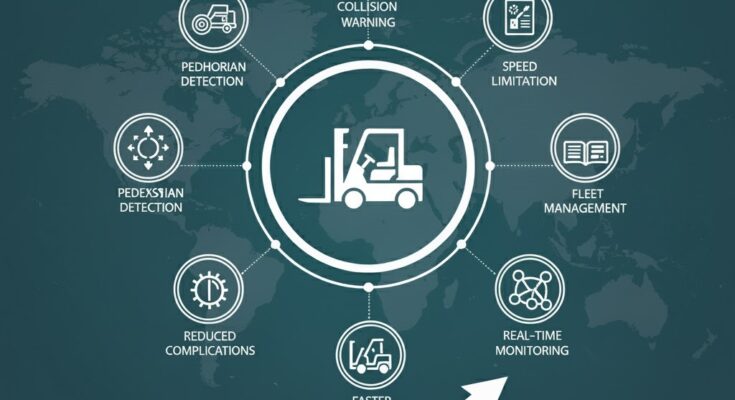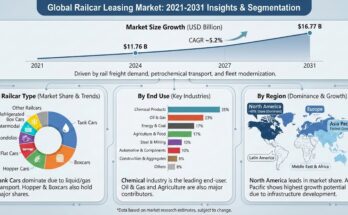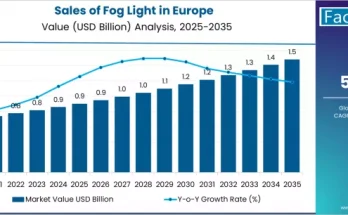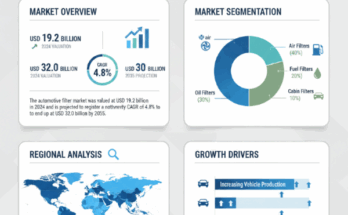According to the latest report by Fact.MR, the global forklift truck safety solution market is projected to grow from USD 6.65 billion in 2024 to USD 22.37 billion by 2034, expanding at an impressive CAGR of 12.9% during the forecast period. This remarkable growth is fueled by rising automation across warehouses and manufacturing units, escalating concerns for worker safety, and the increasing adoption of IoT-enabled fleet monitoring systems.
Strategic Market Drivers
- Industrial Automation and the E-commerce Boom
The surge in online retail and e-commerce has significantly increased warehouse operations and logistics requirements. As fulfillment centers grow larger and more automated, forklift activity intensifies—leading to a greater focus on collision avoidance, pedestrian protection, and operational efficiency. Companies are now investing heavily in advanced forklift safety systems to minimize downtime and ensure accident-free environments.
- Integration of IoT, AI, and Telematics
The incorporation of IoT sensors, AI analytics, and telematics systems is transforming how forklift fleets operate. These solutions deliver real-time data on vehicle location, driver performance, and proximity to obstacles. AI-driven systems can even predict high-risk behaviors and alert operators before accidents occur. This integration not only enhances safety but also boosts productivity and maintenance efficiency across industrial sites.
- Stringent Safety Regulations and ESG Mandates
Global regulatory bodies are enforcing stricter safety guidelines to prevent workplace accidents and injuries. The Occupational Safety and Health Administration (OSHA) and similar organizations worldwide are mandating the use of visual warning systems, speed control mechanisms, and operator-assist technologies. Meanwhile, corporate ESG initiatives are encouraging businesses to invest in sustainable and human-centric safety practices.
Regional Market Insights
North America
North America leads the global market due to its well-established logistics infrastructure, advanced warehousing networks, and proactive safety adoption. The United States, in particular, is witnessing widespread use of telematics-based forklift safety systems to improve fleet efficiency and regulatory compliance. OEMs and aftermarket solution providers continue to collaborate to develop AI-integrated safety platforms tailored for logistics and manufacturing environments.
Europe
Europe remains a vital region due to its strong focus on workplace safety and automation. Countries such as Germany, the UK, and France are investing in intelligent material handling solutions equipped with camera-based systems, speed limiters, and proximity sensors. The region’s industrial modernization policies and support for green logistics are further encouraging adoption of smart, energy-efficient safety technologies.
Asia-Pacific
Asia-Pacific is the fastest-growing region in the global market, led by China, Japan, and South Korea. Rapid industrial expansion, along with the growth of e-commerce, has created enormous demand for forklift fleets. Governments in these countries are supporting smart manufacturing initiatives, leading to widespread deployment of AI-powered monitoring systems and collision prevention technologies. Japan, with its precision engineering and robotics expertise, continues to lead innovations in compact, high-performance safety solutions.
Emerging Markets
The Middle East, Africa, and Latin America are gradually adopting forklift safety solutions as part of broader efforts to enhance industrial efficiency and worker protection. The increasing establishment of smart warehouses and logistics parks, particularly in the UAE, Brazil, and Mexico, is creating lucrative long-term growth opportunities for global players.
Market Segmentation Insights
By Solution Type
- Proximity Sensors & Detection Systems: Widely adopted due to their ability to prevent collisions and protect pedestrians in congested warehouses.
- Camera and Vision Systems: Advanced cameras with AI algorithms enable real-time monitoring of blind spots and operator surroundings.
- Safety Lighting Systems: LED-based blue and red warning lights are gaining traction for visual alerts and night operations.
- Speed & Motion Control Systems: Automated braking and controlled speed mechanisms help reduce accident frequency.
- Telematics & Fleet Management: Cloud-connected systems offering data-driven insights for safety compliance and performance optimization.
By Application
- Warehousing & Distribution: Dominates the market with rapid adoption of smart forklifts and automated safety systems.
- Manufacturing: Increasingly utilizing IoT-enabled forklift solutions for efficient material handling and accident prevention.
- Ports & Logistics Hubs: Adopting rugged, weatherproof systems to ensure safety in heavy-duty operations and high-traffic zones.
Challenges and Market Considerations
Despite robust growth, the forklift safety solution market faces several challenges.
- High Implementation Costs: Advanced sensors and software integrations can increase upfront costs, especially for small and medium-sized enterprises.
- Technological Complexity: Ensuring consistent system reliability under varying environmental conditions—such as dust, lighting, or humidity—requires continuous innovation and calibration.
- Operator Acceptance: While automation improves safety, operators need training and trust in digital systems for widespread adoption.
- Cybersecurity Concerns: As forklift systems become more connected, data protection and secure communication protocols are essential.
Competitive Landscape
The market is characterized by a mix of OEMs and technology innovators offering integrated safety solutions.
Leading companies include:
- Rombit – Specializes in smart wearable safety and proximity detection for industrial environments.
- Toyota Material Handling – Innovating automated forklifts with built-in collision detection and telematics systems.
- Mitsubishi Heavy Industries – Offers advanced safety modules integrated into warehouse automation systems.
- Crown Equipment Corporation – Recently introduced ProximityAssist, a LiDAR-based collision prevention system enhancing driver visibility and training.
- Pelican Manufacturing – Focuses on intrinsically safe industrial lighting and certified safety accessories for high-risk work zones.
- Others – Numerous regional players are emerging with low-cost, customizable safety platforms catering to local market needs.
Recent developments include strategic partnerships between OEMs and tech firms, R&D investments in AI-driven operator monitoring, and global rollouts of connected safety ecosystems for large-scale industrial clients.
Future Outlook
The Forklift Truck Safety Solution Market is on the brink of a major technological transformation. As automation, AI, and IoT reshape industrial environments, safety systems are evolving from passive tools to intelligent, predictive, and data-driven solutions. The next decade will see strong momentum in sensor fusion, real-time hazard detection, and cloud-based analytics, transforming how safety is managed in warehouses and manufacturing units worldwide.



